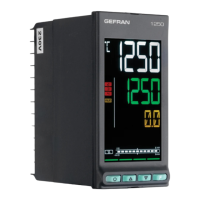65
Unit of measurement: -
Options: J.TC = J thermocouple
K.TC = K thermocouple
R TC = R thermocouple
S TC = S thermocouple
T.TC = T thermocouple
C.TC = C thermocouple
D.TC = D thermocouple
PT2.TC = Pt20Rh / Pt40Rh thermocouple
INFR1 = IR sensor type 1
INFR2 = IR sensor type 2
INFR3 = IR sensor type 3
INFR4 = IR sensor type 4
PT100 = Pt100 resistance thermometer
PT.LIM = Pt 100 limitated resistance thermometer
JTP10 = JPT100 resistance thermometer
60MV = 0...60 mV sensor
20MA = 0...20 mA sensor
4-20M = 4...20 mA sensor
10V = 0...10 V sensor
2-10V = 2...10 V sensor
5V = 0...5 V sensor
1-5V = 1...5 V sensor
1V = 0...1 V sensor
0.2-1V = 0,2...1 V sensor
C.RTD = RTD sensor with user calibration
C.60MV = 0...60 mV sensor with user calibration
C.20MA = 0...20 mA sensor with user calibration
C.4-20 = 4...20 mA sensor with user calibration
C.10V = 0...10 V sensor with user calibration
C.2-10 = 2...10 V sensor with user calibration
C.5V = 0...5 V sensor with user calibration
C.1-5V = 1...5 V sensor with user calibration
C.1V = 0...1 V sensor with user calibration
C.0.2-1 = 0,2...1 V sensor with user calibration
4.7.2. Lin - Selecting linearization type
Acronym Scrolling message Submenu Attributes
Lin CUSTOM LINEARIZATION I.MAIN R W
The parameter sets linearization for the selected sensor type.
The function corrects any linearity and proportionality errors in the correlation between the value sent by the input and
the actual value of the physical quantity measured.
This correction can be made with two different algorithms: 32-step linearization and 4-point linearization. Values are set (33 for 32-step
linearization and 4 for 4-point linearization) with the LINRZ submenu parameters.
For an explanation of 4-point linearization, see paragraph “5.4. 4-point input correction page 141.
Unit of measurement: -
Options: NONE = No linearization
32.STP = 32-step linearization
4.POIN = 4-point linearization
T
V
correlation
of input
Ideal
correlation
4. CONFIGURATION

